Jupiter Is Perpetually Covered With Clouds Composed Of Ammonia Crystals And Possibly Ammonium Hydrosulfide.
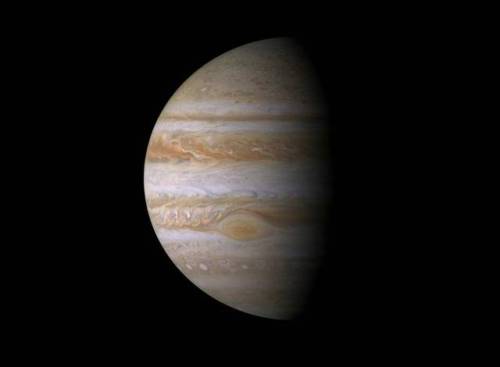
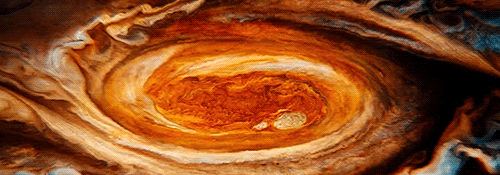
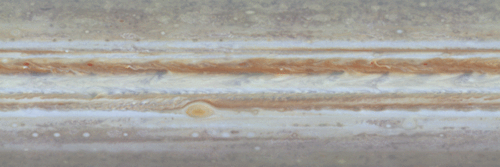
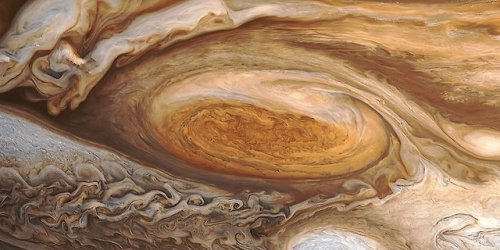
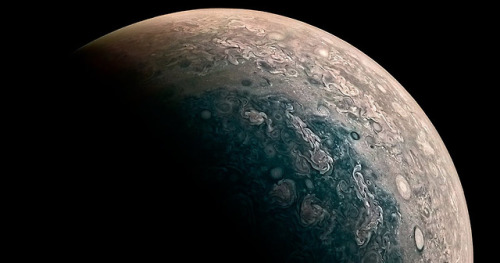
Jupiter is perpetually covered with clouds composed of ammonia crystals and possibly ammonium hydrosulfide. The clouds are located in the tropopause and are arranged into bands of different latitudes, known as tropical regions. These are sub-divided into lighter-hued zones and darker belts. The interactions of these conflicting circulation patterns cause storms and turbulence. Wind speeds of 100 m/s (360 km/h) are common in zonal jets. The zones have been observed to vary in width, color and intensity from year to year, but they have remained sufficiently stable for scientists to give them identifying designations.
The cloud layer is only about 50 km (31 mi) deep, and consists of at least two decks of clouds: a thick lower deck and a thin clearer region. There may also be a thin layer of water clouds underlying the ammonia layer. Supporting the idea of water clouds are the flashes of lightning detected in the atmosphere of Jupiter. These electrical discharges can be up to a thousand times as powerful as lightning on Earth. The water clouds are assumed to generate thunderstorms in the same way as terrestrial thunderstorms, driven by the heat rising from the interior.
source
More Posts from Starry-shores and Others
oh my god. apparently during the making of the Voyager golden record they had to fly the recorder by commercial airlines to add some material onto the record last minute and they booked a seat for it under the name of Mr. Equipment

Voyager: The Golden Record
It’s the 1970s, and we’re about to send two spacecraft (Voyager 1 & 2) into space. These two spacecraft will eventually leave our solar system and become the most distant man-made objects…ever. How can we leave our mark on them in the case that other spacefarers find them in the distant future?
The Golden Record.

We placed an ambitious message aboard Voyager 1 and 2, a kind of time capsule, intended to communicate a story of our world to extraterrestrials. The Voyager message is carried by a phonograph record, a 12-inch gold-plated copper disk containing sounds and images selected to portray the diversity of life and culture on Earth.
The Golden Record Cover
The outward facing cover of the golden record carries instructions in case it is ever found. Detailing to its discoverers how to decipher its meaning.
In the upper left-hand corner is an easily recognized drawing of the phonograph record and the stylus carried with it. The stylus is in the correct position to play the record from the beginning. Written around it in binary arithmetic is the correct time of one rotation of the record. The drawing indicates that the record should be played from the outside in.

The information in the upper right-hand portion of the cover is designed to show how the pictures contained on the record are to be constructed from the recorded signals. The top drawing shows the typical signal that occurs at the start of the picture. The picture is made from this signal, which traces the picture as a series of vertical lines, similar to ordinary television. Immediately below shows how these lines are to be drawn vertically, with staggered “interlace” to give the correct picture rendition. Below that is a drawing of an entire picture raster, showing that there are 52 vertical lines in a complete picture.

Immediately below this is a replica of the first picture on the record to permit the recipients to verify that they are decoding the signals correctly. A circle was used in this picture to ensure that the recipients use the correct ratio of horizontal to vertical height in picture reconstruction.

The drawing in the lower left-hand corner of the cover is the pulsar map previously sent as part of the plaques on Pioneers 10 and 11. It shows the location of the solar system with respect to 14 pulsars, whose precise periods are given.

The drawing containing two circles in the lower right-hand corner is a drawing of the hydrogen atom in its two lowest states, with a connecting line and digit 1 to indicate that the time interval associated with the transition from one state to the other is to be used as the fundamental time scale, both for the time given on the cover and in the decoded pictures.
The Contents
The contents of the record were selected for NASA by a committee chaired by Carl Sagan of Cornell University and his associates.

They assembled 115 images and a variety of natural sounds, such as those made by surf, wind and thunder, birds, whales and other animals. To this, they added musical selections from different cultures and eras, and spoken greetings from Earth-people in fifty-five languages, and printed messages from President Carter and U.N. Secretary General Waldheim.

Listen to some of the sounds of the Golden Record on our Soundcloud page:
Golden Record: Greetings to the Universe
Golden Record: Sounds of Earth

Songs from Chuck Berry’s “Johnny B. Goode,” to Beethoven’s Fifth Symphony are included on the golden record. For a complete list of songs, visit: https://voyager.jpl.nasa.gov/golden-record/whats-on-the-record/music/

The 115 images included on the record, encoded in analog form, range from mathematical definitions to humans from around the globe. See the images here: https://voyager.jpl.nasa.gov/golden-record/whats-on-the-record/images/
Making the Golden Record
Many people were instrumental in the design, development and manufacturing of the golden record.

Blank records were provided by the Pyral S.A. of Creteil, France. CBS Records contracted the JVC Cutting Center in Boulder, CO to cut the lacquer masters which were then sent to the James G. Lee Record Processing center in Gardena, CA to cut and gold plate eight Voyager records.

The record is constructed of gold-plated copper and is 12 inches in diameter. The record’s cover is aluminum and electroplated upon it is an ultra-pure sample of the isotope uranium-238. Uranium-238 has a half-life of 4.468 billion years.
Learn more about the golden record HERE.
Make sure to follow us on Tumblr for your regular dose of space: http://nasa.tumblr.com

NGC 4590 (M68) Globular Cluster
33,000 light years from the Earth, this globular cluster has an odd orbit around our galaxy, orbiting like a comet does around a star, and moving away as far as 100,000 light years from the centre.
It’s theorised that it’s likely a captured cluster, and appears to be undergoing core collapse, where the gravitational influence of the entire cluster bares down at the centre and causes black holes and dense stars to slowly migrate towards the centre, much as our own galaxy has the same mechanism creating the central black hole.
Isn’t it kind of bananas that for most of human history we’ve been completely oblivious to how utterly environmentally tumultuous the planet has historically been? Before the advent of paleontology, conventional wisdom posited that the earth has more or less looked the same for as long as its been around, but soon enough naturalists like Georges Cuvier came along and said, “well it actually turns out that most of the organisms that have ever existed are actually no longer with us,” thereby introducing the entire concept of extinction to the human race?? Do you realize how coconuts that must have sounded back then?
Not only that, but the more we delved into paleontology the more it became apparent that the Earth has spent so much of its existence (about a billion years) being completely unsuitable and even hostile to life as we know it. A significant stretch of the cosmic timeline classifies our planet as being an oxygen-poor wasteland constantly pounded by asteroids and brimming with active super volcanoes. Even after life on Earth started to stretch out its stubby little amphibious legs we’ve had like five mass extinctions events almost completely fuck it all up (including one known as the Permian extinction which killed off no less than 70% of the planet’s land-based life and 96% of its sea critters). Can you recognize how rare and unlikely it is that out of all the downright catastrophic times any of us could have existed as unfortunate little trilobites or dimetrodons we actually get to exist as humans beings who can learn about this stuff with the help of a scientific discipline that effectively allows us to peer back into the reaches of the past?? Anyway, here’s wonderwall
What are brown dwarfs?
In order to understand what is a brown dwarf, we need to understand the difference between a star and a planet. It is not easy to tell a star from a planet when you look up at the night sky with your eyes. However, the two kinds of objects look very different to an astronomer using a telescope or spectroscope. Planets shine by reflected light; stars shine by producing their own light. So what makes some objects shine by themselves and other objects only reflect the light of some other body? That is the important difference to understand – and it will allow us to understand brown dwarfs as well.

As a star forms from a cloud of contracting gas, the temperature in its center becomes so large that hydrogen begins to fuse into helium – releasing an enormous amount of energy which causes the star to begin shining under its own power. A planet forms from small particles of dust left over from the formation of a star. These particles collide and stick together. There is never enough temperature to cause particles to fuse and release energy. In other words, a planet is not hot enough or heavy enough to produce its own light.

Brown dwarfs are objects which have a size between that of a giant planet like Jupiter and that of a small star. In fact, most astronomers would classify any object with between 13 times the mass of Jupiter and 75 times the mass of Jupiter to be a brown dwarf. Given that range of masses, the object would not have been able to sustain the fusion of hydrogen like a regular star; thus, many scientists have dubbed brown dwarfs as “failed stars”.

A Trio of Brown Dwarfs
This artist’s conception illustrates what brown dwarfs of different types might look like to a hypothetical interstellar traveler who has flown a spaceship to each one. Brown dwarfs are like stars, but they aren’t massive enough to fuse atoms steadily and shine with starlight – as our sun does so well.

On the left is an L dwarf, in the middle is a T dwarf, and on the right is a Y dwarf. The objects are progressively cooler in atmospheric temperatures as you move from left to right. Y dwarfs are the newest and coldest class of brown dwarfs and were discovered by NASA’s Wide-field Infrared Survey Explorer, or WISE. WISE was able to detect these Y dwarfs for the first time because it surveyed the entire sky deeply at the infrared wavelengths at which these bodies emit most of their light. The L dwarf is seen as a dim red orb to the eye. The T dwarf is even fainter and appears with a darker reddish, or magenta, hue. The Y dwarf is dimmer still. Because astronomers have not yet detected Y dwarfs at the visible wavelengths we see with our eyes, the choice of a purple hue is done mainly for artistic reasons. The Y dwarf is also illustrated as reflecting a faint amount of visible starlight from interstellar space.
In this rendering, the traveler’s spaceship is the same distance from each object. This illustrates an unusual property of brown dwarfs – that they all have the same dimensions, roughly the size of the planet Jupiter, regardless of their mass. This mass disparity can be as large as fifteen times or more when comparing an L to a Y dwarf, despite the fact that both objects have the same radius. The three brown dwarfs also have very different atmospheric temperatures. A typical L dwarf has a temperature of 2,600 degrees Fahrenheit (1,400 degrees Celsius). A typical T dwarf has a temperature of 1,700 degrees Fahrenheit (900 degrees Celsius). The coldest Y dwarf so far identified by WISE has a temperature of less than about 80 degrees Fahrenheit (25 degrees Celsius).
Sources: starchild.gsfc.nasa.gov & nasa.gov
image credit: NASA / JPL-Caltech
Can you tell us something about j1407b?
J1407b is an exoplanet (but it can also be a brown dwarf) very interesting, orbiting its star J1407. It is larger than Saturn or Jupiter, and is surrounded by a ring system that is about 200 times larger than the rings of Saturn, very different from what we are accustomed to see.

Thirty-seven rings extending 90 million kilometers from the planet — over half the distance from the Earth to the sun — encircle the world. These planetary rings are the first found outside the solar system.

This exoplanet is 434 light-years away in the constellation Centaurus.

J1407b could house moons that could be formed by the material of the rings. One of their moons could be as large as Mars or Earth, and could orbit between the gaps of the rings, shaping them.

Astronomers expect the rings to become thinner in the next million years and eventually disappear as they form satellites from the material of the rings.

The discovery of the J1407 system and its unusual eclipses were reported by the team led by astronomer Eric Mamajek of the University of Rochester in 2012. The orbital period of J1407b is estimated at about a decade.
Simulation of the eclipse of the star J1407 by the ring system around its putative exoplanet J1407b. Each time a ring passed in front of the star, it dimmed. When entering a gap, the star brightened up again. Graphing the highs and lows, scientists created a profile of the ring system.

What the rings of J1407b would look like in our sky (above the Old Observatory in Leiden, Netherlands) if it was located where Saturn is now.
image 1°, image 2°, image 3°, image 4, image 5° & image 7°
Here are some links if you want to read more about it: here, here and here.
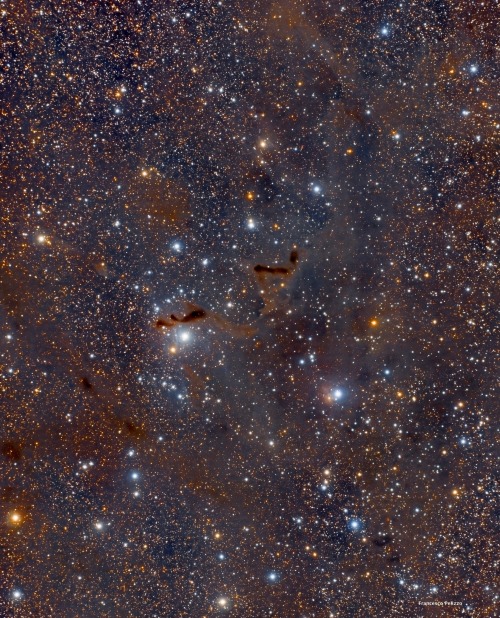
A Giving Hand, vdB9 // DocRx
-
 dontworrymum-differentiscool reblogged this · 5 months ago
dontworrymum-differentiscool reblogged this · 5 months ago -
 dontworrymum-differentiscool liked this · 5 months ago
dontworrymum-differentiscool liked this · 5 months ago -
 junosjukebox reblogged this · 5 months ago
junosjukebox reblogged this · 5 months ago -
 randomkiwibirds reblogged this · 7 months ago
randomkiwibirds reblogged this · 7 months ago -
 gerdchen liked this · 7 months ago
gerdchen liked this · 7 months ago -
 lopez122417 liked this · 7 months ago
lopez122417 liked this · 7 months ago -
 morriganwarrior liked this · 7 months ago
morriganwarrior liked this · 7 months ago -
 rafawriter reblogged this · 7 months ago
rafawriter reblogged this · 7 months ago -
 rafawriter liked this · 7 months ago
rafawriter liked this · 7 months ago -
 dgcatanisiri reblogged this · 7 months ago
dgcatanisiri reblogged this · 7 months ago -
 xploseof reblogged this · 7 months ago
xploseof reblogged this · 7 months ago -
 screwyouflightlieutenant reblogged this · 8 months ago
screwyouflightlieutenant reblogged this · 8 months ago -
 ofspades reblogged this · 8 months ago
ofspades reblogged this · 8 months ago -
 moocowmoocow reblogged this · 8 months ago
moocowmoocow reblogged this · 8 months ago -
 runawaybeard reblogged this · 8 months ago
runawaybeard reblogged this · 8 months ago -
 darkgalaxycat liked this · 8 months ago
darkgalaxycat liked this · 8 months ago -
 asmuchasidliketo liked this · 8 months ago
asmuchasidliketo liked this · 8 months ago -
 mx-treant reblogged this · 8 months ago
mx-treant reblogged this · 8 months ago -
 mx-treant liked this · 8 months ago
mx-treant liked this · 8 months ago -
 onichophora reblogged this · 8 months ago
onichophora reblogged this · 8 months ago -
 millionmovieproject reblogged this · 8 months ago
millionmovieproject reblogged this · 8 months ago -
 screwyouflightlieutenant liked this · 8 months ago
screwyouflightlieutenant liked this · 8 months ago -
 aeromantica liked this · 8 months ago
aeromantica liked this · 8 months ago -
 onichophora liked this · 8 months ago
onichophora liked this · 8 months ago -
 pigeontheoneandonly reblogged this · 8 months ago
pigeontheoneandonly reblogged this · 8 months ago -
 forlornmelody reblogged this · 8 months ago
forlornmelody reblogged this · 8 months ago -
 chryso-poeia liked this · 8 months ago
chryso-poeia liked this · 8 months ago -
 tartelette-aux-fraises liked this · 8 months ago
tartelette-aux-fraises liked this · 8 months ago -
 sasazuka liked this · 8 months ago
sasazuka liked this · 8 months ago -
 dalarans reblogged this · 8 months ago
dalarans reblogged this · 8 months ago -
 knittedgauntlets liked this · 8 months ago
knittedgauntlets liked this · 8 months ago -
 toreodaughter liked this · 8 months ago
toreodaughter liked this · 8 months ago -
 revengeofthecis reblogged this · 8 months ago
revengeofthecis reblogged this · 8 months ago -
 bioticbooty reblogged this · 8 months ago
bioticbooty reblogged this · 8 months ago -
 buugbee reblogged this · 8 months ago
buugbee reblogged this · 8 months ago -
 buugbee liked this · 8 months ago
buugbee liked this · 8 months ago -
 darkinternalthoughts liked this · 8 months ago
darkinternalthoughts liked this · 8 months ago -
 sassyredux reblogged this · 8 months ago
sassyredux reblogged this · 8 months ago -
 sewer-olm reblogged this · 8 months ago
sewer-olm reblogged this · 8 months ago -
 sewer-olm liked this · 8 months ago
sewer-olm liked this · 8 months ago -
 spookycerezacolaaa reblogged this · 8 months ago
spookycerezacolaaa reblogged this · 8 months ago -
 feministthembot reblogged this · 8 months ago
feministthembot reblogged this · 8 months ago -
 lenny-kosnowski liked this · 8 months ago
lenny-kosnowski liked this · 8 months ago -
 saphirweretigrx liked this · 8 months ago
saphirweretigrx liked this · 8 months ago -
 futsin reblogged this · 8 months ago
futsin reblogged this · 8 months ago -
 futsin liked this · 8 months ago
futsin liked this · 8 months ago -
 pigeontheoneandonly liked this · 8 months ago
pigeontheoneandonly liked this · 8 months ago

Amateur astronomer, owns a telescope. This is a side blog to satiate my science-y cravings! I haven't yet mustered the courage to put up my personal astro-stuff here. Main blog : @an-abyss-called-life
212 posts

